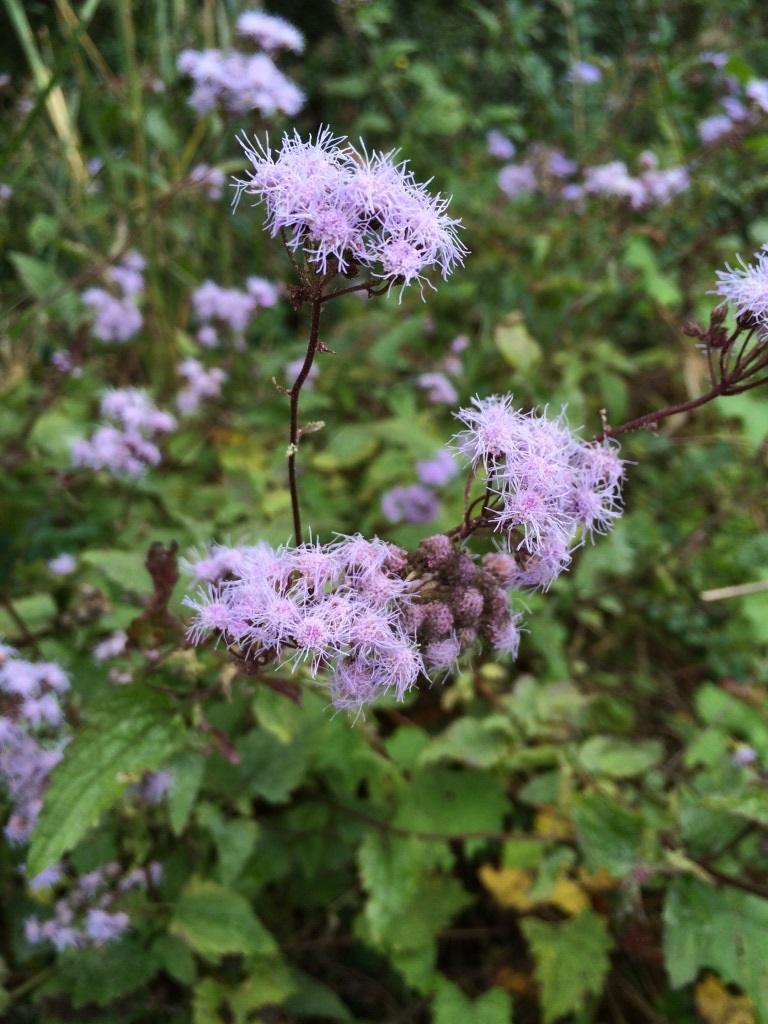
by Mary Salinas | Nov 18, 2014
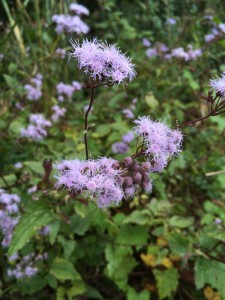
Blue Mistflower – Image Credit Mary Derrick, UF / IFAS
Here’s a beautiful native perennial wildflower that is easy to grow and generally available in the independent nursery trade. In the wild, you can encounter them at the edges of woodlands and ponds as they prefer moist areas. Blue mistflower, Conoclinium coelestinum, performs well as a perennial in the home landscape but does spread easily by seed and will spread in the garden. It also spreads through underground rhizomes which allow it to form large clumps. This is an advantage for the informal garden, however, the gardener who prefers a more formal look will have a bit more maintenance in controlling that spread.
The abundant flowers look like bluish-purple puffballs on the top of the stems. The color is unusual and adds a striking touch in the garden. The bloom season is mid-summer to mid-fall. Butterflies are frequent visitors, making this an excellent addition to your butterfly garden.
Blue mistflower has a full rounded form and will grow to 3 feet under optimum conditions. Leaves are opposite and have a triangular shape. Growth and blooming is best in full sun to part sun conditions.
Give it a try!
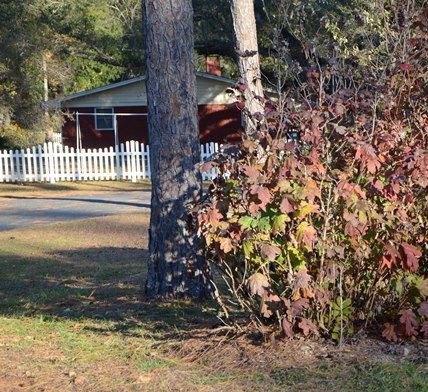
by Les Harrison | Nov 18, 2014

Even though the lawn and landscape are going dormant, there is much which can be done now to prepare for Spring 2015.
Even though it is not officially winter and the landscape is becoming dormant. With the exception of live oak trees, all the plants and trees which lose their leaves are now dropping them to the ground.
For the north Florida homeowners consumed with plans for the holidays, late November is a tempting time to let the landscape take care of itself during this winter’s nap.
This is not necessarily the best plan. There are plenty of task to handle which will make the upcoming growing season more productive and easier.
First on the list of winter’s lawn and garden task is taking a soil sample. It is simple, inexpensive, and efficient from both an economic and environmental standpoint.
Stop by the local UF/IFAS County Extension Office to pick up a free kit which is used to mail the samples, with a processing fee, to the UF Soil Test Lab. The report is usually returned in under two weeks.
Depending on the analysis chosen, the report will deliver the samples soil pH, or the nutrients needed and the soil pH. This is useful information for the spring and summer growing season, and during winter’s dormant period.
People with wood burning fireplaces should be particularly aware of the soil pH which is a measure of acidy or alkalinity. The pH range helps determine the potential success of plants, vegetables and shrubs which will grow in the sampled soil.
Fireplace ash is alkaline and an excellent soil amendment, if the soil pH is too low. However, if the soil pH is too high, then the fireplace ash only aggravates the existing problem of growing desirable plants and grasses.
Many Florida soils tend to have a high concentration of phosphate, an important and useful plant nutrient in the right quantities. Having a soil analysis early which identifies the amount of phosphate available in the land gives the homeowner or garden manager plenty of time to locate a source of blend-fertilizer with the correct amount of phosphate.
The second task on the list is to manage the leaves, mulch and thatch. Each has the potential to be an asset to the landscape, or a hazard.
Leaves should be raked up before they have the time to smother the grass. A carpet of leaves in the yard may appear very seasonal, but usually work against the objective of those who ultimately want a green grassy yard.
As leaves decompose, they leach acidic nutrient into the soil. This is especially true of oak leaves and pine needles.
Another issue is leaf litter and thatch, produced from grass clippings, which will provide an ideal breeding ground for fungi and diseases. The cool, moist recesses common to thatch will incubate any number of problems which will appear in the spring to ruin the perfect yard.
Rake the leaves and use in flower beds or compost heaps. The shrubs will overwinter better with the leaf insulation which keeps the root zone at the correct moisture level and provides desirable nutrients to the plants.
Dethatch lawn mechanically to remove excess debris. Use the excess organic material as mulch or in a compost pile.
The landscape will show its appreciation by returning in a healthy and strong condition in Spring 2015.
To learn more about winter landscapes visit the nearest UF/IFAS County Extension Office. Additional information will be found in the Florida Lawn Handbook
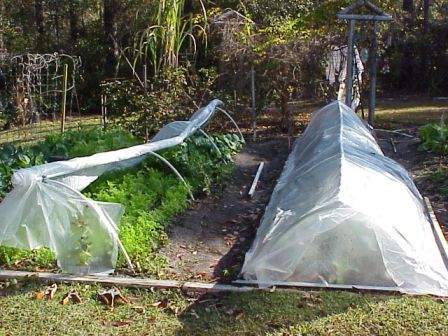
by Eddie Powell | Nov 17, 2014
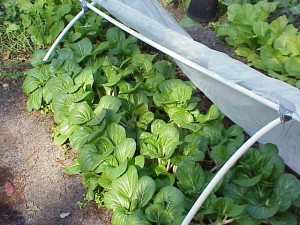
Northwest Florida homeowners enjoy growing their own vegetables every fall, but are faced with cold weather issues, especially during the first few days of December. For example, most cole crops can be planted until November, but they must be protected from the cold weather or they will need to be replaced. A good variety of cold tolerant plants should be used in order to prevent total devastation of the garden by extremely cold weather.
Below are a few tips to assist the home gardener in growing a successful winter vegetable crop.
- For tender plants, site selection should the top priority when preparing for a freeze. Vegetable plants need a site with good air drainage; not in a low area where cold air settles. Arranging tender plants along a barrier to protect them from cold winds improves the plants cold protection, especially from very hard freezes.
- Poorly drained soils result in weak and shallow roots which are more susceptible to cold injury.
- Plants grown with the correctly applied rate of nutrients will tolerate colder temperatures better and recover from cold injury faster than plants grown with little to no nutrients.
- Watering vegetable garden plants before a freeze can help protect plants. A well watered soil will absorb more solar radiation than dry soil and will radiate heat during the night. This may increase cold tolerance by as much as 2°F.
- Saturated soil conditions can damage the root systems of most plants over a few days, so make sure the ground is well-drained.
- Healthy vegetable plants are more resistant to cold than vegetable plants weakened by disease, insect damage, or nematode damage. Routine inspection for pests and implementation of necessary control measures are essential.
- Plastic or cloth coverings can help protect vegetable plants more from frost than from extreme cold. Covers that extend to the ground and are not in contact with the vegetable plants foliage will reduce cold injury. If the vegetable plant foliage is in contact with the cover it is often cold burned or injured because of heat transfer from the foliage to the colder cover. Some examples of excellent plant covers are cloth sheets, quilts or black plastic. If plastic covering is used, it is extremely important to remove the covering during the day to provide for ventilation of trapped heat.
- Feel free to contact your local county extension office for information on cold protection, pest identification and recommended control measures.
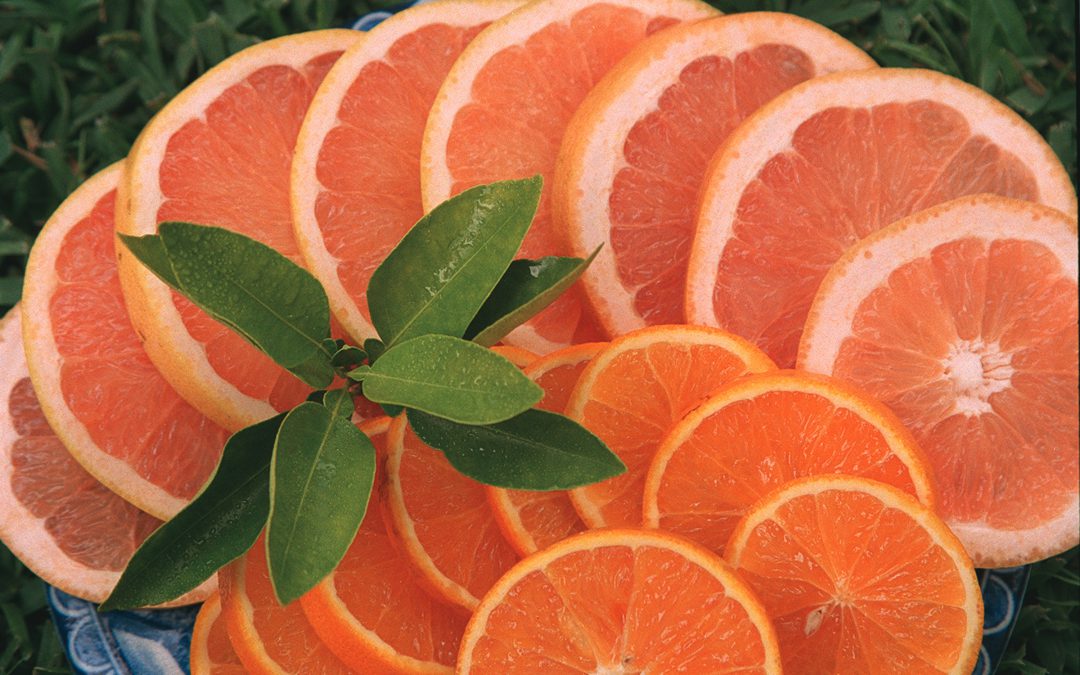
by Matthew Orwat | Nov 17, 2014
Tuesday November 19th and Wednesday November 20th, substantial freezing weather is expected
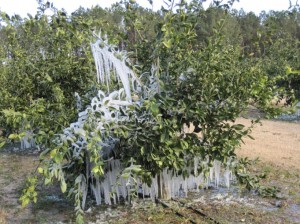
How cold does it have to get before citrus in Northwest Florida needs to be protected? A concrete answer to this question does not exist. Growers and home gardeners alike must consider several factors including type of citrus grown and the location of the citrus.
Below are a few quick facts to assist growers and home gardeners in determining whether to protect or not to protect their citrus:
- Certain citrus trees such as lime, pomelo, grapefruit, sweet orange, lemon and citron will definitely need protection or need to be moved into a sheltered area. Individuals that grow these types on a consistent basis either wrap their trees with protective covers each season or grow them in containers and move them into greenhouses.
- The meyer lemon, which is in reality a lemon-sweet orange hybrid, is a tree that was introduced to the united states in 1908. Mature dormant meyer lemons can be hardy down to 20°F, with fruit hardy to 26°F. Immature trees, or those that have not reached dormancy, should be protected. Covers made of cloth should be large enough to touch the ground so that heat from the soil can help keep the tree warm.
- Generally, satsuma are cold tolerant down to 15° F, but young trees or trees yet to achieve dormancy are usually only tolerant to 26°F. Fruit should not sustain damage from freezing temperatures above 25°F. Extreme winds sometimes make the effects of freeze events worse, so it is always better to err on the side of protection if the trees are planted in an exposed site.
- Kumquats are the most cold tolerant citrus type grown in Northwest Florida, so protection is not required unless freeze events reach 20°F.
Additional facts to assist the grower or home gardener with citrus protection:
- Plant trees on a south-facing slope, south of windbreaks, on the south side of a structure or under a light canopy if possible. South facing slopes block harmful cold winds. Structures offer radiant heat which aids in the protection of citrus trees. Additionally, light over-story pine canopies allow sufficient sunlight through while reducing frost damage.
- Wrap the trunk with commercial tree wrap or mound soil around the base of the tree up to 2 feet. This will protect the graft of the young tree. Thus, if the branches freeze the graft union will be protected.
- Cover the tree with a cloth sheet or blanket. For additional protection, large bulb Christmas lights can be placed around the branches of the tree. This will increase the temperature under the cover by several degrees. Be sure to use outdoor lights and outdoor extension cords to avoid the potential of fire.
- Water citrus trees. Well watered trees have increased cold hardiness. Do not over-water. If the ground is moist, it is not necessary to water.
- Frames may be installed around young trees to hold the cover. This option keeps the blanket or sheet from weighing down the branches.
- For large production areas, micro-irrigation is an option. This practice will protect citrus trees up to 5 feet, but must be running throughout the entire freeze event. For additional information read this publication on micro-sprinkler irrigation.
- Always remember to remove cold protection once the temperature rises so that the trees do not overheat.
- Do not cover trees with plastic tarp, these will not protect the tree and can “cook” the tree once the sun comes out.
For additional information, contact your local extension office.

by Eddie Powell | Nov 11, 2014
Compost is partially decomposed organic matter or anything that was once a living plant. It is the product of controlled decomposition of organic materials by microorganisms. Humus is completely decomposed organic matter.
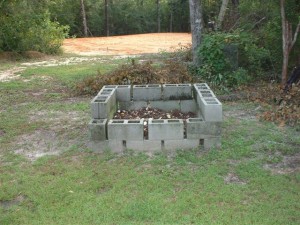
Concrete Block Compost Bin
Photo Credit : Eddie Powell
Green and brown materials with favorable proportions of carbon and nitrogen (C:N) (25:1) offer the microorganisms a “complete meal“. This helps the breakdown of the compost. Greens having high nitrogen and browns having high carbon.
“Green”
- High Nitrogen
- Fast to decompose
- Nitrogen provides the microbes with the raw element of proteins to build their bodies and reproduce.
Examples: manure, kitchen waste, grass clippings, inorganic nitrogen rich fertilizers.
“Brown”
- High Carbon
- Slow to decompose
- Carbon is the energy source for the microbes that help break down the materials.
Examples: leaves, wood chips, straw, sawdust.
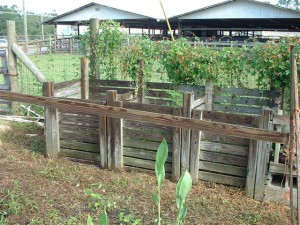
Wooden Compost Bin
Picture Credits : Eddie Powell
Layering in Compost Bin
The general rules for composting: 3 – 4″ layers alternating Green (high nitrogen) and Brown (high carbon) materials. Water each layer as you build it so material is moist not wet, like a wrung sponge. End with a Brown layer on top. Thin layers help prevent anaerobic (smelly) pockets from developing and allows microbes access to both Green and Brown food sources. Do not use meat (eggshells are OK) or dog / cat manure in your compost.
Make sure to filter your composting system because it may not break down all the larger materials, such as corncobs or wood chips.
When you screen your compost, any material larger than your screen size will be removed. The screened particles can be placed back in the compost bin to provide aeration. Additionally, the microbes attached to these pieces will help jump-start the new composting process.
For more information check out this site: Compost Tips for the Home Gardener.










